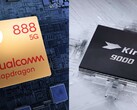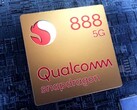Qualcomm touted the 5 nm Snapdragon 888 to show significant improvements over the preceding Snapdragon 865. Xiaomi was among the first OEMs to lap up the Snapdragon 888 in the flagship Mi 11. With the device being available in China, the first benchmarks of the phone are already available. However, it seems that Qualcomm's latest flagship SoC may not really be a very efficient offering.
Various benchmarks of the Mi 11 have been posted by reviewers on Weibo including Geekbench, GFXBench, AnTutu, SPECInt, 3DMark, PUBG: Mobile, and Genshin Impact. These results were collated and analyzed by Golden Reviewer on YouTube.
On the performance front, the Snapdragon 888 clearly shows good leads over the Snapdragon 865 and even beats the Apple A13 Bionic in Geekbench. While raw performance is definitely better, Qualcomm seems to have achieved it at the cost of power efficiency.
Firstly, in AnTuTu, the results show a steep 12 °C increase in temperature and a 4% battery loss at the end of the benchmark. While the battery loss is as expected, most current flagships only show about a 4-5 °C temperature increase. A point to be noted here is that the Mi 10 Pro does not show such abnormal behavior.
Moving on, a SPECint benchmark on the Cortex-X1 Big Core clocked at 2.84 GHz shows 26% higher performance than the Snapdragon 865's Cortex-A77 at the same clock, but the power consumption seems to be a whopping 65% higher. For perspective, a Snapdragon 865 consumes just 2.03 W while the ill-fated Exynos 990 consumes 3.8 W.
Coming to mid-core performance in the same benchmark, the Snapdragon 888's Cortex-A78 cores clocked at 2.42 GHz offer just a 7% performance increase over the same cores in the 865, but seem to consume 25% higher power at 1.88 W compared to 1.5 W in the 865.
Higher power consumption means a greater probability for throttling if the device isn't really able to supply the required power to run the chip at its full potential. That being said, real-world results may not be so bad after all.
In a PUBG: Mobile test, the reviewer noted that at HDR+ settings, the phone pulled between 0.8 to 1 A current and could maintain a stable 60 fps all the time without producing much heat. The battery seemed to have dropped from 86% to 77% after about 30 minutes of gaming.
Going by these numbers, it seems that the total power consumption is between 3.2 and 4 W, which is about the same as the Snapdragon 865. 3DMark Wild Life stress test also didn't seem to show any tangible improvement compared to the Mi 10 Pro.
Genshin Impact, however, proved to be too much for the Mi 11 with the device reaching 50 °C 10 minutes into the game and frames dropping from 60 fps to about 30 fps due to throttling.
The initial results don't seem to paint a rosy picture for Qualcomm's latest flagship and the Mi 11 as well. However, do remember that these results could very well be device-specific and may improve over time with firmware updates. It is also possible that we may see some improvements with the global variant of the Mi 11.
We look forward to comprehensively test the Mi 11 along with other Snapdragon 888-powered devices ourselves in the coming months so stay tuned.
























